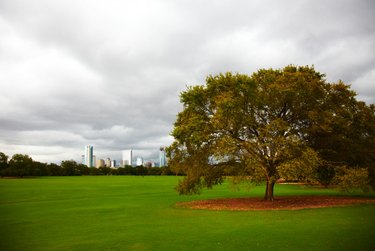
When ugly bare spots dot your lawn, or you need to establish a new lawn, planting grass seed at the right time will increase your chances of success. Healthy, lush lawns usually do not grow on their own. They need care and monitoring to root and sprout, but some varieties of grass seed require more attention than others. The best time to plant grass seed depends on you and the type of seed you have chosen. In general, fall is the best season for planting grass, but this is not always the case.
Weeds
Video of the Day
Weeds can choke new grass plants, and can prevent seeds from sprouting. When weeds are a problem in the yard, you must kill the weeds before attempting to sow grass seeds. Kill the weeds with chemical or organic weed control products. Do not apply any weed control products to the soil after sowing the grass seed.
Video of the Day
Disease
Bacterial and fungal infections can cause grass to turn brown and die, leaving bare spots on the lawn. If your lawn is infected with a disease, the new grass seed will fail to thrive. When you have areas of brown grass, or bare spots that shade, traffic and abuse of the lawn cannot explain, your lawn may have an infection. Treat the bare areas with an anti-fungal product and look for an improvement in grass growth and spreading before planting additional grass seed.
Time
Growing grass from seeds requires a considerable time commitment in most cases. You must water the seed one to two times a day until the grass begins growing. In addition to watering, you must prevent traffic over the area and keep pests and wind from removing your seeds. Spreading a thin layer of straw over the seeds will often help keep the seeds in place until they germinate.
Temperature
Some grass seed is warm-season, while other types are cold-season seeds. Warm-season seed is the most common, and you must plant this type of seed when there is no threat of frost, usually early fall or late spring. On the other hand, cold-season grass seed needs a period of cooler temperatures to properly germinate. Plant these seeds in late fall where they will lay dormant through winter, or in early spring when the summer's heat is still a few weeks away.